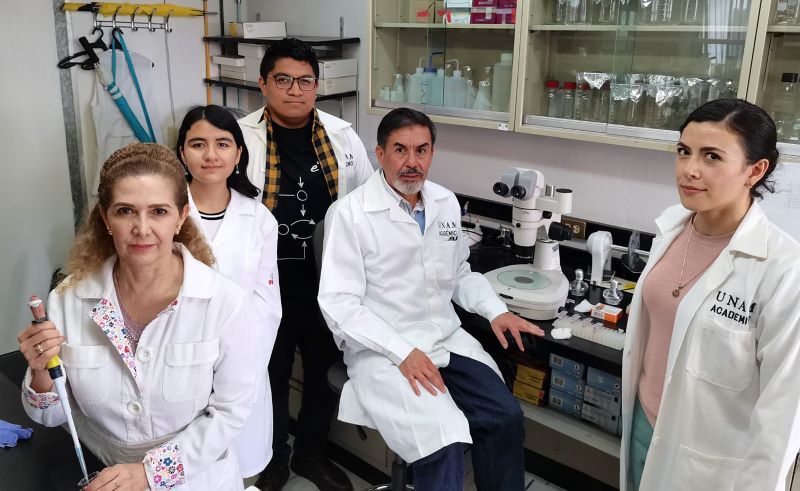The Importance of AzuCR RNA in Regulating Gene Expression
Discover the significance of AzuCR, a small chain of RNA. The study of small RNAs could lead to an understanding of disease mechanisms, improve human health, and treat cancer by reducing or stopping its expression in cancer cells.

The Chinese philosopher Han Shan said, "It is necessary to be careful with small things because their absence or presence can change everything," a phrase that perfectly fits a small chain of ribonucleic acid (RNA) discovered and named AzuCR by Juan Miranda Rios of the UNAM Institute of Biomedical Research (IIBO).
"If we know how RNAs work, we can tackle complex problems like obesity, diabetes, and, in the long run, cancer," said the coordinator of the Nutrition Genetics Unit at the National Pediatrics Institute's peripheral unit of the IIBO.
The small chain was discovered by Miranda Ríos during a stay in the laboratory of Gisela Storz, from the National Institutes of Health in the United States; it is 164 bases long and codes for a small protein of 28 amino acids, but its participation is very important in the regulation of genes related to the metabolism of various sugars.
"When I noticed that the expression of this small RNA is regulated by different sugars, my boss in the United States, Dr. Storz, asked me how to say sugar in Spanish, so the RNA was called AzuCR and the protein it encodes was AzuC, so the name is linked to the functions it has," commented the researcher.
The study of these molecules may have an impact on human health since some of the diseases in humans may have their origin in the fact that some small RNAs or small proteins, such as AzuCR or the AzuC protein, are not produced. So far, only a dozen RNAs with dual functions have been discovered, three of them thanks to the study of Escherichia coli (E. coli) bacteria, one of which was recently named by a university researcher.
Unveiling the Mystery of Small RNAs
Deoxyribonucleic acid, or DNA, is known as the "chain of life" because it contains the information that makes up every living thing. However, no cell can form without someone to translate that information, and that is the job of ribonucleic acid, or RNA, which makes proteins.
The studies that led to this discovery in the 1960s were carried out in bacteria, and later it was discovered that the same occurred in more complex organisms. In the early 1990s, it was found that there were RNAs that also could regulate gene expression; they were called small RNAs because their size ranged from 30 to 300 bases, and when they joined other RNAs, they affected their capacity to produce proteins.
Before RNA was hardly considered, the important thing in cells was DNA and proteins, since it was not believed that they had functions in the regulation of gene expression. In addition, some of these small molecules can also produce small proteins that have important functions in the virulence of pathogenic bacteria, which is why they have also been called RNAs with dual functions.
In 2003, the General Direction of Academic Staff Affairs supported Miranda Ríos to study techniques that allow the analysis of these small RNAs, one of which is today called AzuCR, which modulates the use of carbon in Escherichia coli (E. coli) bacteria and encodes a 28-amino-acid protein (called AzuC).
After this sabbatical at UNAM, the researcher kept working on the project that led to the article "Dual function AzuCR RNA modulates carbon metabolism," which was published in the US journal Proceedings of the National Academy of Sciences in 2022.
Some of the known dual RNAs are important for the virulence of some pathogens, like Staphylococcus aureus or Vibrio cholerae. Knowing how these small RNAs and the functions of their proteins work can help doctors come up with ways to stop them from doing their jobs and improve human health.
"It is important to recognize that the study of these RNAs is leading us to understand some disease mechanisms that were previously unknown." Thinking that some of these genes were going to produce proteins, it turned out that many of the diseases could not previously be attributed to there being a defective gene. "Now we know that there are genes that produce RNAs, which if not produced in the right amount, can cause diseases," commented the researcher.
By studying these RNAs, we could learn more about how diseases like obesity, diabetes, and some types of cancer are caused. This would help us come up with ways to treat cancer by reducing or stopping its expression in cancer cells.
Miranda Ríos is currently studying models of obesity in a type of worm called Caenorhabditis elegans (C. elegans) to see how different diets (high in sugar and fat) modify the expression of these small RNAs, considering that many of the genes that encode proteins and small RNAs are very similar in humans.
"If we add a lot of glucose or fatty acids to the agar in which the worms grow, the worms eat them and get fatter or bigger than worms that don't eat glucose." "They also live shorter lives and are less fertile," she added.
This is very similar to what happens in humans, as obese people live shorter lives, have more difficulty reproducing children, and their energy generation functions are altered. The university expert and his team are also looking at how these small molecules are expressed to come up with ways to stop them from doing their jobs and reduce the changes in cancer cells.




